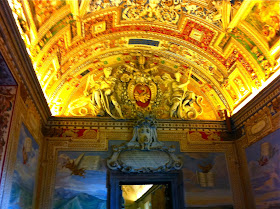Facts on the Sistine Chapel:
1. The Sistine Chapel was built by a Pope named Pope Sixtus the Vl, hence the name Sistine Chapel.
2. The Sistine Chapel was built to house the Cardinals while they deliberated on who should become the next Pope.
3. The famous chimney that releases black smoke telling us the Pope has died and white smoke telling us we have a new Pope is set up in the Sistine Chapel? You can see the marks where it sits towards the back right of the chapel.
4. No artist in history suffered as much as Michelangelo suffered in the 4 years it took him to complete the ceiling of the Sistine Chapel. He suffered with his knees, back and neck and he still managed to live to be 89 years old.
5. Michelangelo painted the Last Judgement (the front wall of the Sistine Chapel) 28 years after he finished the Sistine ceiling.
6. The Sistine Chapel was completely cleaned between the years 1980 to 1999. It was paid for by the camera company Fuji Film. Fuji Film now own all copyright to the paintings, and that is why there is no photography allowed in the Sistine Chapel.
7. Michelangelo’s enemy, Rapheal, was originally asked to paint the Ceiling of the Sistine Chapel but refused. He suggested Michelangelo knowing he was a sculpture and not a painter.
8. Pope Julius ll (the Pope that commissioned Michelangelo to paint the ceiling of the Sistine Chapel) sold Indulgences in order to pay Michelangelo for his work. Selling Indulgences meant that people could pay money to get time off Purgatory.
9. Michelangelo was intimidated by the scale of the commission, and made it known from the outset of Julius II's approach that he would prefer to decline. He felt he was more of a sculptor than a painter, and was suspicious that such a large-scale project was being offered to him by enemies as a set-up for an inevitable fall. For Michelangelo, the project was a distraction from the major marble sculpture that had preoccupied him for the previous few years.
10. During occasional ceremonies of particular importance, the side walls are covered with a series of tapestries, the originals of which were designed for the chapel by Raphael and depict events from the Life of St. Peter and the Life of St. Paul as described in the Gospels and the Acts of the Apostles.
11. The southern wall is decorated with the Stories of Moses, painted in 1481–1482. Starting from the altar, they include:
- Moses Leaving to Egypt by Pietro Perugino and assistants
- The Trials of Moses by Sandro Botticelli and his workshop
- The Crossing of the Red Sea by Cosimo Rosselli, Domenico Ghirlandaio or Biagio di Antonio Tucci
- Descent from Mount Sinai by Cosimo Rosselli or Piero di Cosimo
- Punishment of the Rebels by Sandro Botticelli
- Testament and Death of Moses by Luca Signorelli or Bartolomeo della Gatta
12. The northern wall houses the Stories of Jesus, dating to 1481–1482. They include:
- Baptism of Christ by Pietro Perugino and assistants
- Temptation of Christ by Sandro Botticelli
- Vocation of the Apostles by Domenico Ghirlandaio
- The Sermon on the Mount, attributed to Cosimo Rosselli
- The Delivery of the Keys by Pietro Perugino
- The Last Supper by Cosimo Rosselli
View of the Vatican outside the window our our walk!
13. The Chapel is a high rectangular brick building, its exterior unadorned by architectural or decorative details, as common in many Medieval and Renaissance churches in Italy. It has no exterior facade or exterior processional doorways, as the ingress has always been from internal rooms within the Apostolic Palace (Papal Palace), and the exterior can be seen only from nearby windows and light-wells in the palace.
I love the trees in Rome!
14. Eastern Wall
- Resurrection of Christ by Hendrik Van den Broeck (1572) over Domenico Ghirlandaio's original
- Disputation over Moses' Body by Matteo da Lecce (1574) over Luca Signorelli's original
The Popes Crosses!
The Popes Bibles!
Cappella Sistina that a way!
Inside the Sistine Chapel! It was the most amazing work of art to see ever! The detail was incredible! Everything looked so real!
The Creation of Adam by Michelangelo, the most famous painting found at the Sistine Chapel and also one of the most famous paintings in the world! Michelangelo was a genius! The pure enormity of the work and the impression it leaves upon you is hard to forget.
The way out!
Italian Word of the Day:
Sorprendente meaning Amazing/Astonishing
PEACE & LOVE,
Kevin & Amanda






















No comments:
Post a Comment